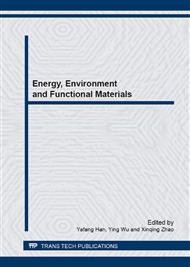p.419
p.425
p.431
p.436
p.442
p.448
p.454
p.460
p.468
Preparation of Oleophobic Surface on X70 Pipeline Steel
Abstract:
The oleophobic surface has extremely broad application prospects in industrial production and daily life. It can prevent the adhesion of materials and fouling, and prolong the service life. In this investition, an oleophobic surface on X70 pipeline steel specimen was prepared successfully by the combination of sandblasting, chemical etching, and low energy modification. The microstructure and oleophobicity of the surface were studied by scanning electron microscope (SEM), contact angle tester, and confocal microscope. The results showed that micro-nanocomposite structure on the specimen was formed after sandblasting and chemical etching of concentrated hydrochloric acid aqueous solution. The low-energy modification of perfluorooctanoic acid anhydrous ethanol solution just covered the surface, but had no obvious influence on the surface morphology. After chemical etching and low-energy modification, the specimen processed by sandblasting for 30s obtained the better oleophobicity, and the maximum contact angle between the surface and engine oil was 130°.
Info:
Periodical:
Pages:
454-459
Citation:
Online since:
April 2014
Authors:
Price:
Сopyright:
© 2014 Trans Tech Publications Ltd. All Rights Reserved
Share:
Citation:


